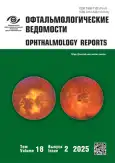Clinical experience with epinastine in patients with seasonal allergic conjunctivitis in ophthalmological practice
- Authors: Polovinkina G.V.1, Gyamdzhyan K.A.2, Pokrovskiy A.S.1, Veprikova Y.G.1, Zvoncova I.N.1, Shtupun D.R.1, Kulikova Y.1
-
Affiliations:
- Diagnostic сenter No. 7 (ophtalmologic) for adults and children
- Ranbaxy
- Issue: Vol 18, No 2 (2025)
- Pages: 61-68
- Section: Original study articles
- Submitted: 10.01.2025
- Accepted: 17.06.2025
- Published: 18.07.2025
- URL: https://journals.eco-vector.com/ov/article/view/645377
- DOI: https://doi.org/10.17816/OV645377
- EDN: https://elibrary.ru/BLLLZH
- ID: 645377
Cite item
Abstract
BACKGROUND: Allergic conjunctivitis involves an inflammatory reaction that destabilizes the tear film and promotes dry eye syndrome. Topical antihistamines may contribute to ocular surface dryness.
Aim: The study aimed to compare the tolerability and clinical effect of topical dual-action anti-allergic agents, including 0.05% epinastine, 0.2% olopatadine, and 0.1% olopatadine, in patients with seasonal allergic conjunctivitis in a standard clinical practice.
METHODS: The study included 33 patients (66 eyes) with seasonal allergic conjunctivitis. The patients were equally divided into three groups to receive 0.05% epinastine (n=11), 0.2% olopatadine (n=11), and 0.1% olopatadine (n=11). Symptom severity was assessed using the itching scale, Efron grading scale, eyelid edema scale, and Munk scale for epiphora grading. Dry eye symptoms were assessed using the Schirmer and Norn tests. The therapy duration was 14±2 days.
RESULTS: By the study end, mean tear film breakup time in the 0.05% epinastine group almost did not change compared to baseline and was 9.4±1.41 s vs. 9.6±1.39 s (OD) and 9.3±1.34 s vs. 9.5±1.43 s (OS). However, in the 0.1% and 0.2% olopatadine groups, it decreased and was 13.9±3.21 s vs. 11.6±2.88 s (OD) (p=0.043), 14.1±3.25 s vs. 11.6±3.06 s (OS) (p=0.019) and 10.63±1.51 s vs. 8.5±1.41 s (OD) (p=0.003), 10.75±1.28 s vs. 8.63±1.3 s (OS) (p=0.003), respectively. The lowest number of adverse reactions was observed in the 0.05% epinastine group.
CONCLUSIONS: 0.05% epinastine caused less dry eye symptoms and was well tolerated in patients with seasonal allergic conjunctivitis.
Full Text
About the authors
Galina V. Polovinkina
Diagnostic сenter No. 7 (ophtalmologic) for adults and children
Email: polovinkina.g.v@yandex.ru
ORCID iD: 0009-0004-9215-2040
MD
Russian Federation, Saint PetersburgKarine A. Gyamdzhyan
Ranbaxy
Author for correspondence.
Email: valinor78@yahoo.com
ORCID iD: 0000-0002-1936-2090
SPIN-code: 5614-7206
MD, Cand. Sci. (Medicine)
Russian Federation, MoscowAndrey S. Pokrovskiy
Diagnostic сenter No. 7 (ophtalmologic) for adults and children
Email: pokrovas@gmail.com
MD
Russian Federation, Saint PetersburgYuliya G. Veprikova
Diagnostic сenter No. 7 (ophtalmologic) for adults and children
Email: yulya.veprikova@mail.ru
MD
Russian Federation, Saint PetersburgInna N. Zvoncova
Diagnostic сenter No. 7 (ophtalmologic) for adults and children
Email: sin_apelsin@mail.ru
MD
Russian Federation, Saint PetersburgDina R. Shtupun
Diagnostic сenter No. 7 (ophtalmologic) for adults and children
Email: makarenko-dina@mail.ru
MD
Russian Federation, Saint PetersburgYuliya Kulikova
Diagnostic сenter No. 7 (ophtalmologic) for adults and children
Email: valinor78@yahoo.com
MD
Russian Federation, Saint PetersburgReferences
- Kimchi N, Bielory L. The allergic eye: Recommendations about pharmacotherapy and recent therapeutic agents. Curr Opin Allergy Clin Immunol. 2020;20(5):414–420. doi: 10.1097/ACI.0000000000000669
- Leonardi A, Piliego F, Castegnaro A, et al. Allergic conjunctivitis: A cross-sectional study. Clin Exp Allergy. 2015;45(6):1118–1125. doi: 10.1111/cea.12536
- Terekhova EP. Allergic conjunctivitis: modern view on clinical forms, diagnosis and therapy. Pharmateca. 2015;(S1):33–39. EDN: TUIKMP (In Russ.)
- Leonardi A, Modugno RL, Salami E. Allergy and dry eye disease. Ocul Immunol Inflamm. 2021;29(6):1168–1176. doi: 10.1080/09273948.2020.1841804
- Swamynathan SK, Wells A. Conjunctival goblet cells: Ocular surface functions, disorders that affect them, and the potential for their regeneration. Ocul Sur. 2020;18(1):19–26. doi: 10.1016/j.jtos.2019.11.005
- Brubaker K, Yerxa BR, Boyer JL. In vitro analysis of the antagonism of the histamine H1 receptor by epinastine: A kinetic comparison with other marketed compounds. Invest Ophthalmol Vis Sci. 2006;47(13):4975.
- Kanai K-i, Asano K, Watanabe S, et al. Epinastine hydrochloride antagonism against interleukin-4-mediated T cell cytokine imbalance in vitro. Int Arch Allergy Immunol. 2006;140(1):43–52. doi: 10.1159/000092001
- Trattler WB, Luchs J, Majmudar P. Elestat (Epinastine HCl ophtalmic solution 0,05 %) as a therapeutic for allergic conjunctivitis. Int Ophtalmol Clin. 2006;46(4):87–99. doi: 10.1097/01.iio.0000212136.77675.b1
- Pradhan S, Abhishek K, Mah F. Epinastine: Topical ophthalmic second generation antihistamine without significant systemic side effects. Expert Opin Drug Metab Toxicol. 2009;5(9):1135–1140. doi: 10.1517/17425250903117284
- Bielory L, Lien KW, Bigelsen S. Efficacy and tolerability of newer antihistamines in the treatment of allergic conjunctivitis. Drugs. 2005;65(2):215–228. doi: 10.2165/00003495-200565020-00004
- Wolf SC, Brubaker K. Evauation of muscarinic receptors antagonism by antihistamines. XXVI Congr Eur Acad Allergy Clin Immunol. 2007;62(83):138.
- Villareal AL, Farley W, Pflugfelder SC. Effect of topical ophthalmic epinastine and olopatadine on tear volume in mice. Eye Contact Lens. 2006;32(6):272–276. doi: 097/01.icl.0000224360.10319.b1
- Clinical Recommendations of the Ministry of Health of Russia. Conjunctivitis, 2024. [Internet]. Available from:: https://library.mededtech.ru/rest/documents/KP629_24/#table_1ktavs
- Maychuk DYu, Drozdova EA, Tarkhanova AA, Zinych EE. Results of observational study and integration of Epinastine 0,05 % in treatment algorythms of patients with seasonal allergic conjunctivitis. Ophthalmology in Russia. 2024;21(2):386–392. doi: 10.18008/1816-5095-2024-2-386-392 EDN: AXNRYG
- Yani EV. Using a new antiallergic drug Epinepta® in the treatment of seasonal allergic conjunctivitis. Clinical cases. Russian Ophthalmological Journal. 2023;16(4):141–146. doi: 10.21516/2072-0076-2023-16-4-1-6 EDN: DQFRWK
- Kovalevskaya MA, Filina LA, Halayqa AI, Nikishina AO. Clinical manifestations and effectiveness of therapy for eye allergy and dry eye syndrome. Russian Ophthalmological Journal. 2024;17(3):35–40. doi: 10.21516/2072-0076-2024-17-3-35-40 EDN: SWTKPH
Supplementary files











